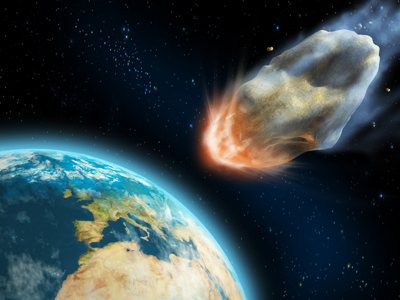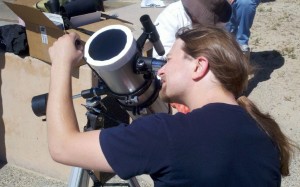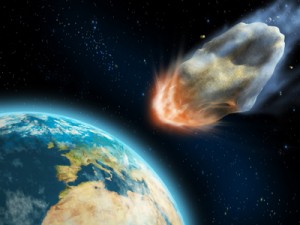
 Key Stars
Key Stars
For observers at mid-northern latitudes, the Pleiades star cluster is due south around 10 P.M. local time. Above it is Perseus, flanked by Auriga and Cassiopeia. Orion can be found above the southeastern horizon, and between it and the celestial pole glitters Capella. High in the east are Castor and Pollux, the brightest stars of Gemini, and below them Leo the Lion is rising. In the southwest is the Square of Pegasus and Vega shines low above the northwestern horizon.
The Planets
Mercury
The normally secretive world is easy to see as December opens, when Mercury shines near magnitude -0.7 and lies about 10 degrees above the southeastern horizon, half an hour before sunrise. A slender crescent Moon lies just 5 degrees to Mercury’s upper right on the morning of December 1, while Saturn appears 3 degrees above our satellite. By mid-month, Mercury reaches magnitude -0.8 and becomes increasingly difficult to spot, a few degrees lower in the bright twilight. As December nears the end, the planet quickly drops out of sight and into the glow of the Sun.
Venus
Venus does not set until almost three hours after the Sun for viewers at mid-northern latitudes this month. It is by far the brightest point of light in the sky, shining at an awesome magnitude -4.7 in the southwest for more than half the duration of the long northern evenings in December.
Mars
Mars rises around 1 A.M. local time on December 1 and an hour earlier by month’s end. The best time to look, however, is just before dawn, when the planet is much higher in the southeast. Mars begins the month in western Virgo, close to Beta Virginis, but its eastward motion carries it within 0.5 degree of Gamma Virginis on the 29th.
Jupiter
By the time early evening is over, you can start looking for Jupiter.
The giant planet rises around 7:30 P.M. local time in early December but breaks the eastern horizon soon after sunset on the 31st, when it remains visible all night. Jupiter spends the month less than 10 degrees southwest of Gemini’s twin stars, Castor and Pollux. On the evenings of December 9 and 10, binoculars will also show 3.5-magnitude Delta Geminorum just 15 arcminutes south of the planet.
Saturn
At the start of December, Saturn is just 15 degrees high in the southeast as dawn begins, but gets a little higher every morning. The ringed planet resides among the background stars of the constellation Libra and remains within 5 degrees of 3rd-magnitude Alpha Librae all month. Through a telescope, Saturn sports an angular size of 16 arcseconds, while the rings span 37 arcseconds.
Uranus
Uranus remains visible well after midnight this month, but it is highest in the south and best observed around 7 P.M. local time in mid-December. At magnitude +5.8, the planet is bright enough to see with the naked eye in a really dark sky. Telescopes will reveal its pale bluish or greenish disk, just 3.5 arcseconds wide.
Neptune
Neptune, in central Aquarius close to 4th-magnitude Iota Aquarii, is well placed for telescopic observing in the early evening. The distant planet then lies due southwest and about a third of the way up from the horizon to the zenith. Neptune shines at magnitude +7.9 and appears a tiny 2.4 arcseconds wide.
Pluto
Ultrafaint Pluto, in Sagittarius, is technically in the evening sky in December. However, the dwarf planet sets soon after the Sun and is in too bright a sky to be seen in most amateur telescopes.
 Asteroids
Asteroids
532 Herculina
This month, Herculina shines at 10th magnitude and moves slowly through the star fields of northern Orion. The easiest way to find it is to center your telescope on Nu Orionis or Xi Orionis (the two stars that mark the handle of Orion’s club) and then move 2 degrees to the north. The asteroid will readily identify itself by its movement within the star field, shifting by about 15 arcminutes (a substantial part of the telescope field) during a twenty-four hour period.
Comets
C/2012 S1 ISON
At the moment of writing this (early morning, December 1), Comet ISON is fading at the rate expected of a simple, inactive debris cloud moving farther from the Sun’s illumination. It now seems unlikely that there will be much to see when the comet (or what is left of it) returns to dawn visibility after December 5. Keep in mid, however, that during most of the last month, Comet ISON brightened and dimmed in unexpected ways. There may be hope yet.
For in-depth information on observing Comet ISON in December, complete with finder maps, please consult the page “Comet ISON – Latest Updates, FAQ and Viewing Guide”
(http://www.nightskyinfo.com/ison/#december). The link points to the “Viewing Guide” section; to explore the page, press “Return to Top”
and use the page navigation links.
C/2013 R1 Lovejoy
At the start of December, C/2013 R1 is 4th magnitude and moves through Bootes the Herdsman, positioned well for mid-northern observers just before dawn. By December 5, the comet shifts into Corona Borealis, where it spends a few days before crossing into Hercules.
Do not miss the chance to see this bright comet from a dark-sky location. Lovejoy should be readily visible to the unaided eye, as a small fuzzball surrounded by a faint halo. Make sure you bring binoculars – they will also show a faint tail, about 2 degrees long.
C/2012 X1 LINEAR
Throughout all of December, C/2012 X1 should remain around 8th magnitude, making it an easy target for 4-inch telescopes. The comet cuts through the constellation Serpens the Snake, and rises about two hours before the start of astronomical twilight for mid-northern observers. By the time dawn begins to brighten, it is already some 30 degrees above the eastern horizon.
Meteor Showers
The Geminids
The Geminids are active from December 4 to 17th and peak very quickly on the night of December 13 – 14. Most activity occurs after midnight on the 14th, when as many as one hundred slow, graceful Geminids might be seen per hour under ideal conditions. This year, however, the Moon shines all the way until daybreak, so bright moonlight will wash out most meteors.
The Ursids
The Ursid shower is active from December 17 to 26th, and peaks on the morning of December 22. The radiant lies near the bright star Kochab (Beta Ursae Minoris), which appears below the Pole Star in the evening and above it before dawn. The radiant is circumpolar from most of the Northern Hemisphere, so viewing can last all night. The Ursids usually produce fairly modest rates, with a typical peak ZHR (Zenithal Hourly
Rate) of about ten.
Sky Events
- December 1 – The Moon is 1.3 degrees south of Saturn (5 A.M. EST).
- December 2 – New Moon (7:22 P.M. EST).
- December 4 – The Moon is at perigee, the point in its orbit when it is nearest to Earth (5:09 A.M. EST).
- December 9 – First Quarter Moon (10:12 A.M. EST).
- December 11 – The Moon is 3 degrees north of Uranus (2 A.M. EST).
- December 14 – The Geminid meteor shower is at peak activity (5 A.M. EST).
- December 17 – Full Moon (4:28 A.M. EST). Uranus is stationary (9 P.M. EST).
- December 19 – The Moon is 5 degrees south of Jupiter (2 A.M. EST). The Moon is at apogee, the point in its orbit when it is farthest from Earth (6:50 P.M. EST).
- December 20 – Venus is stationary (3 P.M. EST).
- December 21 – Winter Solstice (12:11 P.M. EST).
- December 22 – The Ursid meteor shower is at peak activity (5 A.M. EST).
- December 24 – Asteroid 532 Herculina is at opposition (2 A.M. EST).
- December 25 – Last Quarter Moon (8:48 A.M. EST).
- December 26 – The Moon is 1.1 degrees north of Spica (10 P.M. EST).
- December 28 – The Moon is 0.9 degree south of Saturn (8 P.M. EST).
- December 29 – Mercury is in superior conjunction with the Sun (1 A.M. EST).
